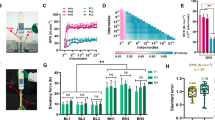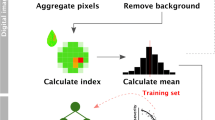Abstract
Multiple regression predictive models based on data acquired by near-infrared (NIR) spectrophotometry suggest that stalk surface wax components contribute towards resistance toEldana saccharina Walker in sugarcane. At least 35 sugarcane clones of known resistance were required to calibrate a predictive model that accounted for approximately 54% of the variation in resistance toEldana. Wavelengths chosen in multiple regression models suggest that alcohols and carbonyls are important in the wax contribution. Through the use of wax fractionation and gas chromatography, a high alcohol/aldehyde ratio and shorter carbon chain length appears to be associated with resistance. The use of NIR in the screening of wild germplasm and the early screening of breeding material for resistance, without prior knowledge of the biochemical mechanisms involved, is an exciting prospect. However, cause-and-effect relationships remain to be shown.
Similar content being viewed by others
References
Anonymous. 1984. Susceptibility of varieties to attack by eldana. p. 8,in Annual Report of the South African Sugar Association Experiment Station, Mount Edgecombe, 4300, South Africa.
Atkinson, P. R. A., Carnegie, A. J. M., andSmaill, R. J. 1981. A history of the outbreaks ofEldana saccharina Walker in Natal.Proc. S. Afr. Sugar Technol. Assoc. 55:111–115.
Arceneaux, G. 1965. Cultivated sugarcanes of the world and their botanical deviation. Proceedings, 12th Congress of the International Society of Sugar Cane Technology, San Juan, Puerto Rico. pp. 844–855.
Avato, P., Bianchi, G., andMurelli, C. 1990a. Aliphatic and cyclic lipid components of sorghum plant organs.Phytochemistry 29:1073–1078.
Avato, P., Bianchi, G., andPogna, N. 1990b. Chemosystematics of surface lipids from maize and some related species.Phytochemistry 29:1571–1576.
Bond, R. S. 1988. Progress in selecting for eldana resistance.Proc. S. Afr. Sugar Technol. Assoc. 62:129–133.
Brennan, R. M., Robertson, G. W., McNicol, J. W., Fyffe, L., andHall, J. E. 1992. The use of metabolic profiling in the identification of gall mite (Cecidophyopsis ribis Westw.) resistant blackcurrent (Ribes nigrum L.) genotypes.Ann. Appl. Biol. 121:503–509.
Carnegie, A. J. M., andSmaill, R. J. 1980. The incidence of moth borers in South African sugarcane during the 1978/79 season.Proc. S. Afr. Sugar Technol. Assoc. 54:154–157.
Goddu, R. F., andDelker, D. A. 1960. Spectra-structure correlations for the near-infrared region.Anal. Chem. 32:140–141.
Kolattukudy, P. E. 1980. Cutin, suberin and waxes, pp. 571–645,in The Biochemistry of Plants, Vol. 4. Academic Press, San Diego, California.
Lamberton, J. A., andRedcliffe, A. H. 1960. The chemistry of sugarcane wax. I. The nature of sugarcane wax.Aust. J. Chem. 13:261–268.
Martens, H., andNaes, T. 1984. Multivariate calibration. I. Concepts and distinctions.Trends Anal. Chem. 3:204–210.
Nuss, K. J., andAtkinson, P. R. A. 1983. Methods used to measure the susceptibility of sugarcane varieties to attack byEldana saccharina Walker.Proc. S. Afr. Sugar Technol. Assoc. 57:92–94.
Osborne, B. G., andFern, T. 1986. Near Infrared Spectroscopy in Food Analysis, Longman, London.
Roach, B. T. 1984. Conservation and use of the genetic resources of sugarcane.Sugar Cane 2:7–11.
Schenk, J. S., andWesterhaus, M. O. 1993. Analysis of Agriculture and Food Products by Near Infrared Reflectance Spectroscopy. Monograph, Infrasoft International, Port Matilda, Pennsylvania 16870.
Tulloch, A. P. 1976. Plant Waxes, pp. 235–287,in P. E. Kolattukudy (ed.). Chemistry and Biochemistry of Natural Waxes. Elsevier, Amsterdam.
Woodhead, S., andTaneja, S. L. 1987. The importance of the behaviour of young larvae in sorghum resistance toChilo partellus.Entomol. Exp. Appl. 45:47–54.
Yang, G., Espelie, K. E., Wiseman, B. R., andIsenhour, D. J. 1993. Effect of corn foliar cuticular lipids on the movement of fall armyworm (Lepidoptera: Noctuidae) neonate larvae.Fla. Entomol. 76:302–316.
Author information
Authors and Affiliations
Rights and permissions
About this article
Cite this article
Rutherford, R.S., van Staden, J. Towards a rapid near-infrared technique for prediction of resistance to sugarcane borerEldana saccharina walker (Lepidoptera: Pyralidae) using stalk surface wax. J Chem Ecol 22, 681–694 (1996). https://doi.org/10.1007/BF02033578
Received:
Accepted:
Issue Date:
DOI: https://doi.org/10.1007/BF02033578




